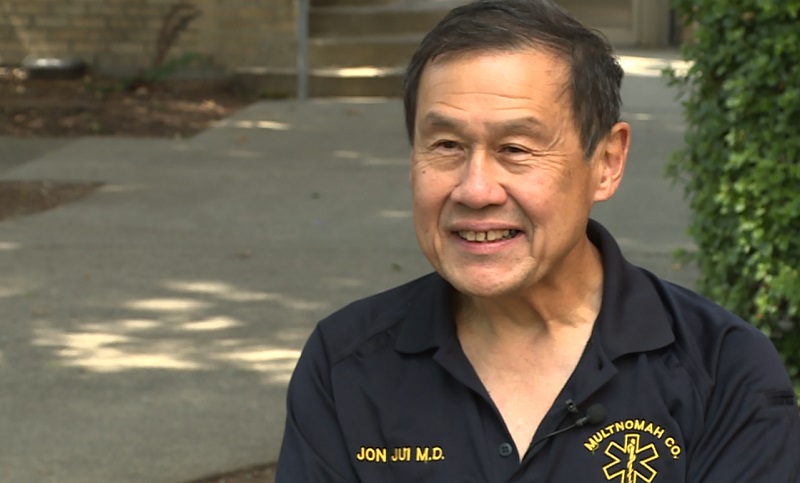PORTLAND, Ore. (KOIN) — Paramedic Chris Tabor works the night shift in Multnomah County. “It’s almost like a different world” when it gets dark in Portland, he said.
“The city slows down and that’s usually when we see the majority of our violent crimes as well as the rest of the sicknesses that weren’t taken care of during the day,” Tabor told KOIN 6 News.
It’s not unusual, he said, for there to be an instance where someone was violent toward a medic every single day.
“Anything from knives being in play, box cutters, obviously the events of people almost getting ran off the road or struck by cars, or just people randomly attacking us in streets with pepper spray, bats, anything they could have.”
‘We acknowledge the problem’
Multnomah County Medical Director Dr. Jon Jui, who has worked in this field for more than 3 decades, is responsible for leading the emergency medical services.

“We acknowledge that the problem is there,” Dr. Jui told KOIN 6 News. “We’ve seen a tremendous rise in violence since the start of COVID to the point that it’s 400-to-600 or even higher percent.”
Many times, he said, the violent patients paramedics encounter are high on drugs. Jui said half or more of the patients are drug-and-alcohol related.
“So it’s basically psychotic behavior caused by drugs,” he said.
Dr. Jui points to 3 main factors contributing to the rise in rage and violence against paramedics and EMS personnel: the pandemic compounded limited resources and restricted socialization in recent years, the pervasive use of meth among their patients, and a lack of drug treatment centers in the region.
“Those are all factors, huge factors, into why we are seeing the number of patients that may be aggressive towards us,” Tabor said.
Dr. Jui compared the line to get into a drug detox center in Multnomah County to a line to get into a game at the Moda Center.
“We know what the problem is. We can’t get them into treatment. You need to have a place to send them to. There’s no place to send them to,” Jui said. “So if you’re higher than a kite and you can’t remember you need to go to detox, that’s the problem here as well. So our system has a long ways to go to improve that care for our patients.”
Tabor said it “can get irritating” when they get called to respond to the same person once or twice a week, especially in a city with 650,000 people.
Jui said he and “the entire system” agrees these repeated encounters with mentally ill and drug-addicted patients turns paramedics into targets.
What paramedics want
The role of the Multnomah County EMS Office, Dr. Jui told KOIN 6 News, is to provide paramedics with medical direction, teaching, equipment and supplies — along with maintaining morale and staffing.
“The issue here is hiring new people at the same time, not losing the people that are working in the field right now,” Jui said, as AMR is struggling to hire even while offering $18,000 signing bonuses.
As a result, paramedics want the county to provide them with better hands-on behavioral health training.
“If you look at how many patients we transport per day and you take into account the percentage of those patients that are behavior related, that’s going to outnumber the amount of cardiac arrests by 10,” Tabor said. “I have practiced cardiac arrests at least four times a year, but I never practice verbal de-escalation of a patient in psychosis.”
Jui agrees: “I think that’s an area that we can improve on.”
Paramedics ask the county to re-evaluate the protocols to include police’s help in restraining potentially violent patients.
“It’s my partner and I usually handling the restraint of the patient and we would like to be able to have more people. Ideally, there should be one individual on each limb to safely restrain, so the patient doesn’t hurt themselves,” Tabor said. “That’s mainly the goal here. It’s our safety and the patient’s safety.”
AMR usually only has two people to respond to calls, compared to fire fighters who travel in groups of four.
“I would say [paramedics] are much more exposed, especially in the back of a moving ambulance,” Dr. Jui added.
When asked if Multnomah County EMS would consider re-evaluating current protocols, Dr. Jui said, “Absolutely, I’m a physician. There’s always room for improvement.”
Paramedics would also like to have access to different, safer vehicles with barriers available for these kinds of transports, different from the typical ambulance.
“I think it would definitely be better than putting someone in a box with their arms and legs tied down to transport them to the hospital,” Tabor said. “A lot of times that’s more traumatizing than what they’re actually going through.”
Dr. Jui said transporting people in this state is tough work and that there’s no perfect way to do it. But he feels strongly that transporting them in an ambulance is the least traumatic and safest for an “unpredictable” and “impulsive” patient.
However, for patients who cross the lines, who commit crimes and put lives at risk, EMS is asking the courts to hold them accountable.
“We show up to everything. We show up to your gunshot wounds and your strokes and your heart attacks. We always show up for you, no matter when it is. And we need someone to show up for us to say it’s not OK for us to keep getting assaulted and shot and stabbed at,” Tabor said. “That’s what we need from Multnomah County, from Multnomah County EMS, from all of our allied partners, is for someone to help us out and stand with us on this to ensure that we can all go home at the end of the day.”
For paramedics to provide the best care to patients, Tabor said, is going to take everybody to be on board. That includes hospitals, county medical direction and the Multnomah County DA’s Office.